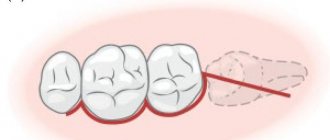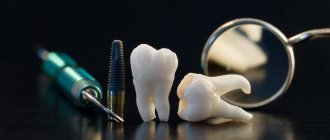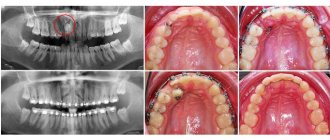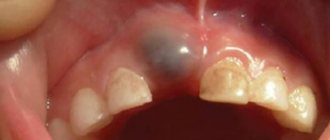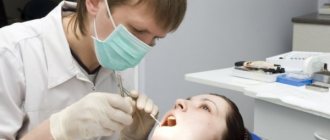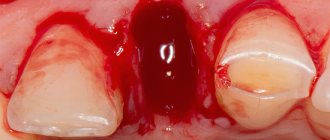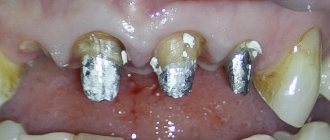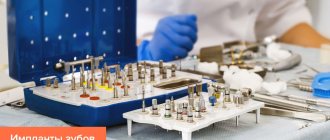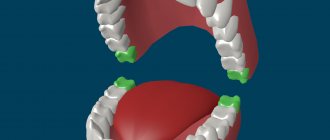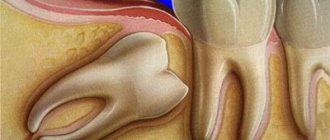Indications for removal
- Acute purulent-inflammatory processes of the maxillofacial zone, for example, osteomyelitis, periostitis, are life-threatening for the patient.
- Long-term endodontic treatment, which did not bring any effect.
- Complete destruction of the crown, which does not allow the use of conservative treatment methods.
- Inability to use the root of a damaged tooth for prosthetics.
- High degree of tooth mobility.
- Preparation for implantation or prosthetics.
- Retention causing inflammation.
Features of complex tooth extraction
To avoid complications, tooth extraction must be preceded by a thorough diagnosis. Based on X-ray images, the surgeon determines the length of the roots and the features of their location, outlines a plan for surgical intervention, and selects optimal anesthesia (additional sedation is recommended for emotionally labile patients). In the presence of an inflammatory process, preventive antibacterial therapy is prescribed.
Discomfort in the postoperative period is a common occurrence with complicated removal. To alleviate the condition, patients are recommended to take painkillers and anti-inflammatory drugs, and physical procedures may be prescribed. Typically, the healing process takes 2-3 weeks, and if the doctor’s recommendations are strictly followed, it proceeds without complications.
Atraumatic removal
If previously tooth extraction was associated with rather unpleasant sensations, today, thanks to new techniques and technologies, such operations are performed using gentle techniques and are practically painless for the patient.
Modern surgery uses atraumatic tooth extraction - an operation that allows, simultaneously with removal, to create conditions for implantation or prosthetics.
Advantages of atraumatic removal:
- This method makes it possible to carry out simultaneous implantation.
- As the name suggests, atraumatic extraction causes significantly less damage to the tissue surrounding the diseased tooth and creates less discomfort for the patient than traditional extraction with forceps.
- When removing complex teeth, surgeons use ultrasonic equipment and instruments that do not injure nerve endings and blood vessels, which reduces the risk of bleeding.
Atraumatic tooth extraction
Atraumatic tooth extraction without fear and pain at the SibDent clinic.
Dental clinic "SibDent" offers services for atraumatic tooth extraction. Thanks to advanced equipment and the latest technologies, atraumatic tooth extraction occurs without pain and damage, with maximum comfort.
Atraumatic tooth extraction is a method of removing teeth, without the use of forceps, which allows you to leave intact the tissue around the tooth that will be removed, which promotes rapid healing of the gums and maintaining the correct relief. Innovative technological developments in the field of surgical dentistry have made it possible to move to a completely new level of tooth extraction.
Indications:
– Severe tooth damage due to injury or infection.
– Inability to cure or restore a damaged tooth.
– Crowding, incorrect position of teeth.
– Advanced form of pulpitis or periodontitis.
– Purulent inflammation around or inside the tooth, which cannot be eliminated without tooth extraction.
– Freeing up space for implant installation.
Atraumatic extraction is fundamentally different from conventional tooth extraction. The essence of this removal is to split the tooth crown into a certain number of parts and, using microsurgical blades, separate the tooth from the connective tissues that connect the bone tissue to the tooth root.
The rehabilitation process after such removal is as comfortable, quick and painless as possible, and the volume is preserved and the relief of the bone tissue is not disturbed.
Compared to traditional tooth extraction, atraumatic extraction has a number of advantages:
- No damage to mucous and bone tissues.
- Painless and quick rehabilitation process.
- Preservation of bone tissue and gum relief.
- Atraumatic tooth extraction is painless.
- Minimal blood loss.
- Possibility of immediate implantation.
The SibDent clinic is equipped with all the necessary equipment that allows for atraumatic tooth extraction. Highly professional dental surgeons will painlessly and quickly perform the procedure of cutting the tooth into several parts and carefully removing it from the socket. The use of only high-quality painkillers ensures that the operation takes place without pain or discomfort.
We have made high technology accessible to everyone!
Removal of a tooth cyst
A dental cyst is a purulent formation covered with a dense membrane. It appears as a consequence of inflammatory processes, including as a result of inadequate or untimely treatment of periodontitis. In most cases, the cyst is discovered in the later stages, when therapy no longer helps and only removal remains. However, proper and high-quality surgical intervention can help preserve a living tooth.
The surgical department of our clinic performs tooth extraction of any complexity. But not in all cases such drastic decisions are needed. The main goal of surgical dentistry is not just to remove a diseased tooth, but to do everything possible to preserve it. Modern technologies and surgical methods make it possible to successfully perform tooth-preserving operations and resort to radical measures only in cases where other methods are inapplicable.
Features of atraumatic tooth extraction
Any tooth extraction is a traumatic procedure affecting the bone and surrounding tissues. It is equally difficult for both the patient and the doctor. So is there a difference in how exactly it will be done? Yes, there is a difference, and a very significant one, because the general condition of the person and the possibility of further implantation will depend on the consequences of such an operation.
How not to remove teeth
Until recently, the only way to forcefully get rid of teeth was the traditional extraction procedure, i.e. breaking out a tooth along with bone fragments. During the operation, the gum peeled off, forceps were applied to the bone in the projection of the tooth root, and the tooth dislocated along with the bone. At the site of the extracted tooth there remained a painful hole that took a very long time to heal.
Restoring the bone structure after such removal took at least six months, and the bone tissue inevitably decreased, complicating the process of subsequent implantation. Now, when doctors are faced with the consequences of such a traumatic removal, they almost always resort to bone grafting, which costs both time and the patient’s wallet.
However, the only “advantage” of such a traumatic removal operation was its speed. This is truly one of the fastest ways to get rid of a tooth, which, obviously, was important in conditions when the doctor had neither suitable anesthesia, nor instruments, nor painkillers in his arsenal. It is curious that patients still come to the clinic who are sure that successful tooth extraction must occur quickly, otherwise either the doctor is incompetent or the tooth is “complicated.”
Removal and implantation in one visit
Modern methods of atraumatic tooth extraction involve minimally invasive intervention using special surgical instruments - periotomes. It is these that surgeons use instead of forceps, dividing the tooth into several fragments and carefully removing each of them.
Contrary to popular belief about the monolithic structure of teeth, their roots are connected to the socket by special collagen ligaments, which, during atraumatic removal, are simply separated, preserving the basic structure of the bone. But in the case of a tooth in which the nerve has been removed, the opposite situation is possible - the root there fuses with the bone, so it has to be fragmented and removed one by one.
Atraumatic removal takes much longer than traditional removal, but as a result, the patient retains the bone walls of the tooth socket, the gums are practically not damaged, and the bone tissue is not reduced. The healing process is easier and faster, so the patient is ready to begin further treatment almost immediately.
Of course, even atraumatic removal does not provide a 100% guarantee that bone grafting or other dental restoration procedures will not be required in the future, but still, with good condition of the oral cavity, a sufficient amount of bone tissue and a carefully conducted preliminary study, modern doctors literally work wonders. For example, they can remove a tooth and place an implant there in one visit, which is of great psychological importance for the patient.
A new type of surgeon
Experts are confident that thanks to the practice of atraumatic tooth extraction, a new type of surgeon has already appeared in the world. These doctors not only know how to remove teeth, but are also well versed in the intricacies of implantation and the procedures that precede it. They understand how to preserve bone tissue for subsequent prosthetics and try to use non-traumatic, minimally invasive methods.
Such specialists undergo additional training, not limited only to the knowledge acquired at the university and their practice. It’s difficult, but there are more and more surgeons like this every year. The dental services market itself demands them.
Patients have also changed a lot over the past few years; they read a lot and know about the latest in dentistry. More than 70% of them ask in detail about the features of the upcoming procedures and the possibility of placing an implant on the day of removal.
All this makes the work of a surgeon truly interesting and competitive.
Complex wisdom tooth removal
From an anatomical point of view, wisdom teeth can be considered rudiments. They do not carry a payload and at the same time cause a lot of problems when cutting through and due to rapid destruction. Often healthy teeth also have to be removed (for example, due to crowding or before dentures).
During a complex wisdom tooth extraction, the dental surgeon performs a series of sequential manipulations:
- in case of incomplete eruption (presence of a “hood”), it cuts through soft tissues;
- saws the tooth piece by piece using a bur;
- if necessary, cuts out adjacent bone tissue;
- applies forceps, rocks and removes tooth segments from the socket;
- puts stitches.
After a complex wisdom tooth extraction, it is mandatory to attend a follow-up appointment to assess the condition of the postoperative wound and exclude possible complications.
Local complications arising after tooth extraction
Bleeding . Tooth extraction is accompanied by minor bleeding. As a rule, the blood coagulates after a few minutes and a blood clot forms in the socket. However, in some cases, even after the formation of a blood clot, continued bleeding may occur, which has a number of causes. Common reasons include increased blood pressure associated with hypertension or increased psycho-emotional stress that accompanies tooth extraction surgery. You should also pay attention to diseases that the patient may suffer from. These are diseases of the blood coagulation and anticoagulation system (hemophilia, thrombocytopenic purpura, Werlhof's disease, Rendu-Osler's disease, etc.). The nature of the drugs that the patient may take, for example anticoagulants, also matters. Patients suffering from cirrhosis and other liver diseases are of particular interest due to impaired prothrombin synthesis. Prevention of the development of bleeding can be a careful collection of anamnesis, a detailed examination of the patient, in particular, mandatory measurement of blood pressure before intervention. Carrying out activities that reduce psycho-emotional stress. Local causes of bleeding are associated with the presence of an inflammatory process in the surrounding tissues and a traumatic tooth extraction operation. First of all, it is necessary to determine where the bleeding is coming from: from the bone socket of the extracted tooth or from soft tissues. To do this, squeeze the edges of the hole with your fingers. If the bleeding stops, then it originated from soft tissue, and if not, then from the bone. In case of bleeding from soft tissues, they are stitched with interrupted sutures with a resorbable thread (vicryl). Usually it is enough to stitch the gum on both sides of the hole and tie the knots tightly. Bleeding from the bone is stopped by destroying and compressing the bone beams by gently tapping the bottom or walls of the socket with a curettage spoon or elevator. If this is ineffective, the hole is tightly packed with iodoform turunda from the bottom, leaving it for 5-7 days. You can also use a hemostatic sponge, which is inserted into the hole. A sterile gauze pad is placed on the socket of the extracted tooth, and the patient is asked to clench his teeth together. After 20-30 minutes, they check whether the bleeding has stopped, and only then the patient is released from the clinic. It is advisable to prescribe medications. A good effect is achieved by intramuscular administration of the hemostabilizer dicinone or sodium ethamsylate or intravenous drip administration of epsilon aminocaproic acid. All activities are carried out with mandatory blood pressure monitoring. If stopping bleeding in an outpatient setting is ineffective, the patient is hospitalized.
Features and advantages of atraumatic tooth extraction
The operation of atraumatic tooth extraction is fundamentally different from the standard one. Its essence is to use modern instruments to split the tooth crown into several parts, and then, using a periotome (ultra-thin blade), to separate the tooth from the connective tissues connecting the tooth root and jaw bone.
Atraumatic tooth extraction has obvious advantages over standard:
- The dissection of the dental crown is carried out using special surgical burs. Their main advantage is fast cutting, eliminating the possibility of excessive vibration and heating of the tooth and surrounding tissues.
- Rapid healing of the wound resulting from the operation minimizes the risk of infections and the development of gum inflammation.
- The possibility of incomplete tooth extraction is excluded.
- The use of laser and ultrasound - more modern and gentle methods of dissecting the coronal part of the tooth - eliminates damage to bone tissue (which is of particular importance during planned implantation), ensures minimal blood loss and, as a result, rapid healing of the socket.
For atraumatic tooth extraction, anesthesia is used. The duration of the operation is 15-20 minutes.
